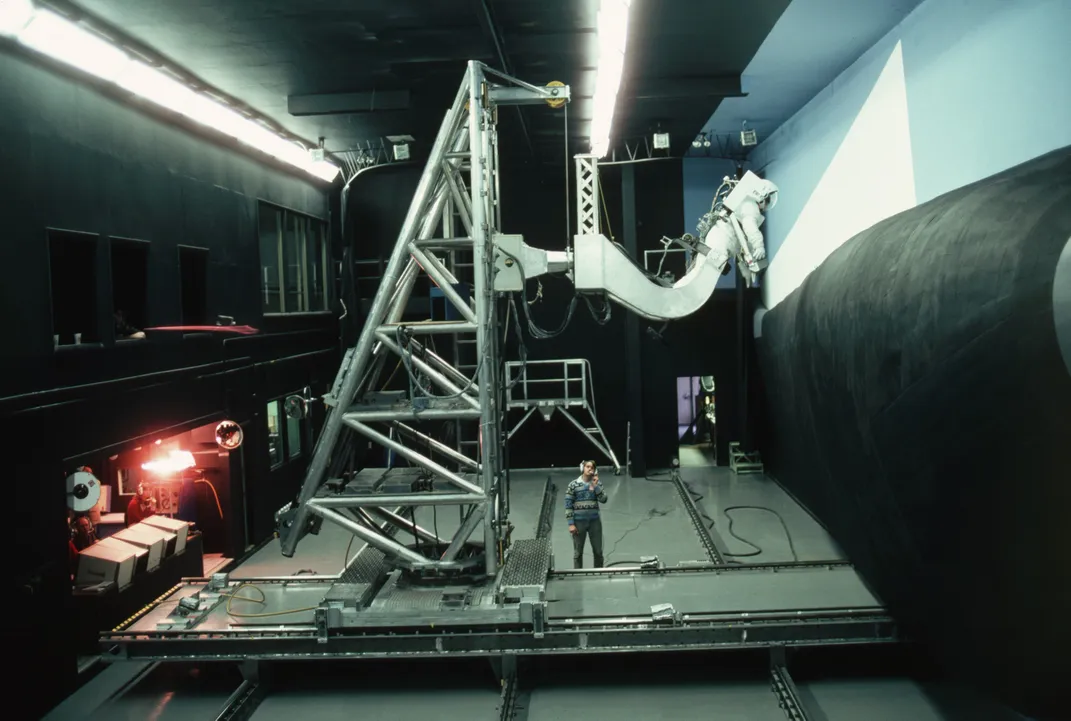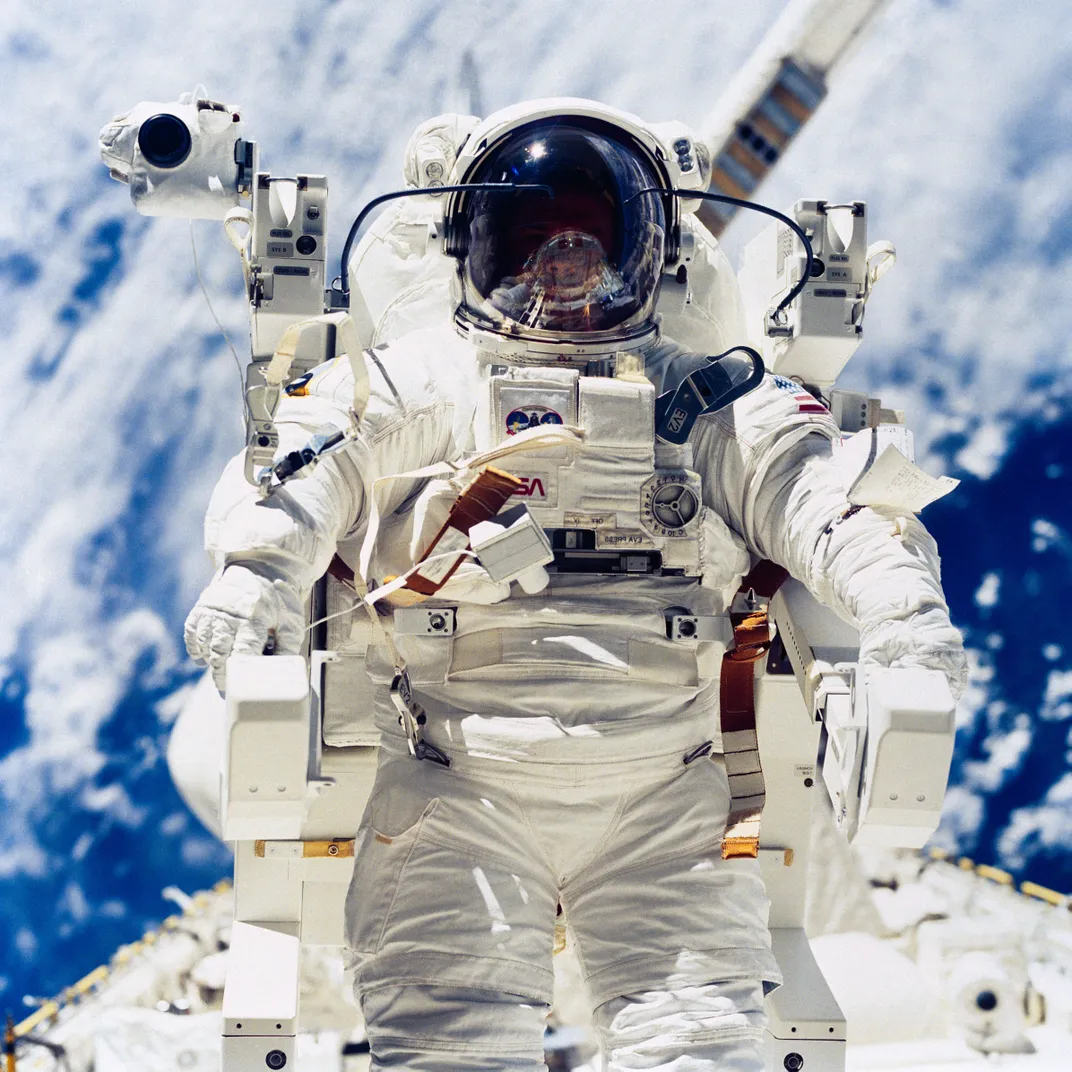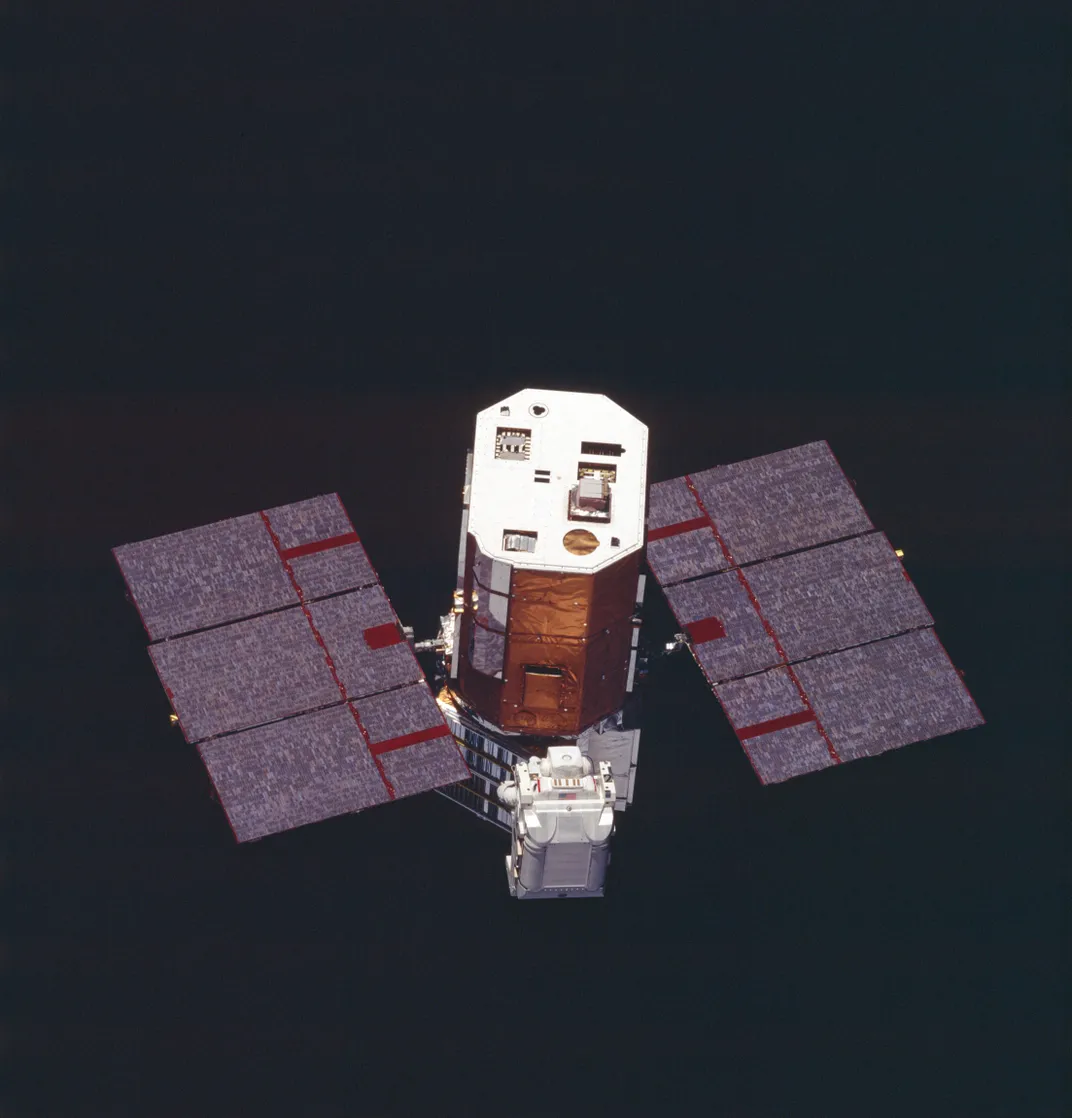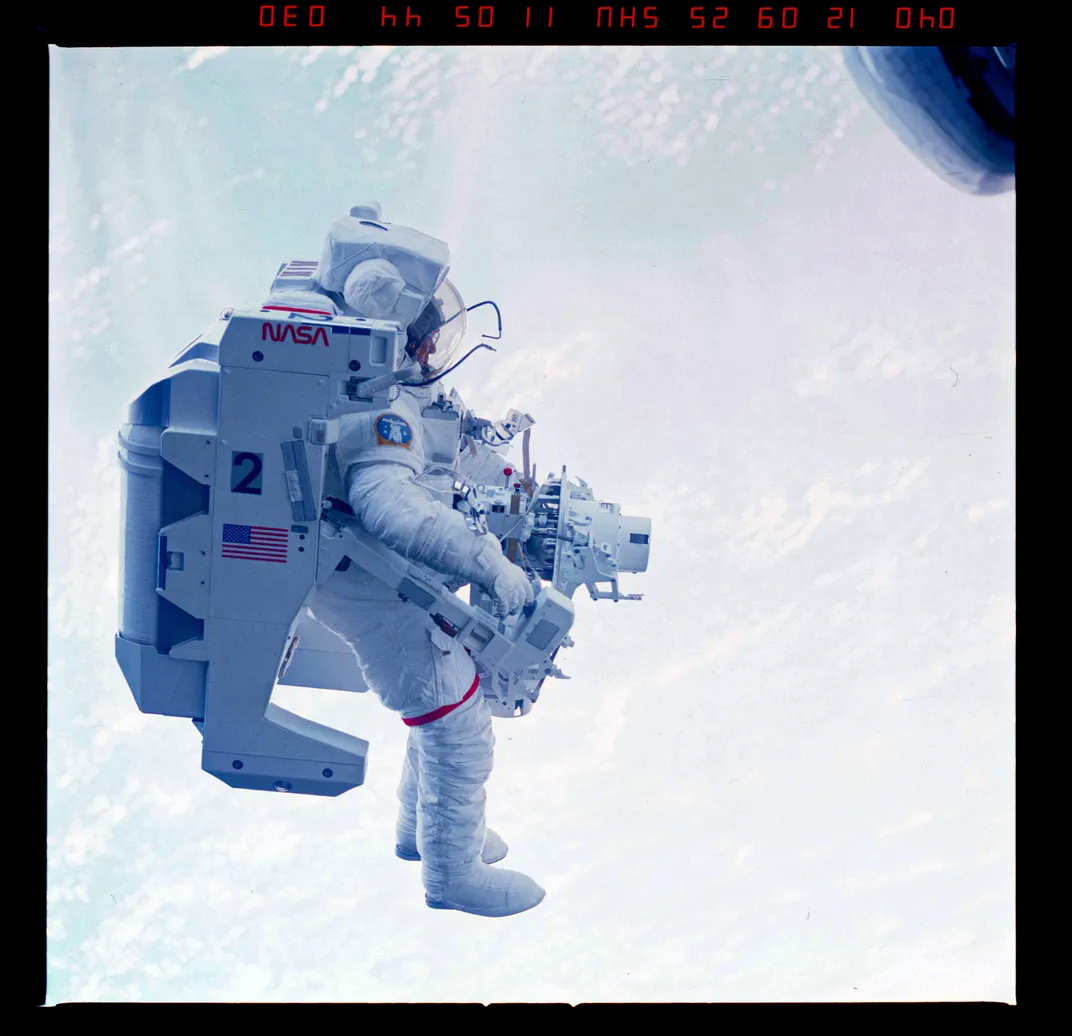Untethered
The MMU may have been the coolest space vehicle ever. So why did its career end as soon as it began?
:focal(2071x1321:2072x1322)/https://tf-cmsv2-smithsonianmag-media.s3.amazonaws.com/filer/1a/08/1a08e11a-d76c-40cd-82bb-a7f2b8871b73/s84-27232.jpg)
The picture is one of the great mind-blowers of the 20th century: Astronaut Bruce McCandless is a tiny, free-flying satellite, 300 feet from the space shuttle Challenger, on the first test flight of the Manned Maneuvering Unit in February 1984. Never mind the personal thrill for McCandless, who had waited 18 years for his first spaceflight, 16 of them spent developing the rocket-powered MMU. The test on shuttle mission STS‑41B was the realization of a dream dating to the early 1960s, before anyone had walked in space, when planners envisioned a jetpack that would let astronauts move effortlessly among space stations and satellites. McCandless’ untethered sortie seemed to herald a new era for spacewalkers. Yet by the end of 1984, the MMU had made its last flight, ending a brief, if spectacular, episode in the shuttle era. What happened?
As alluring as it still seems, the vision of a free-flying astronaut was never a sure thing. Air Force planners developed a prototype of a propulsive backpack in 1962, and a flight model called the Astronaut Maneuvering Unit (AMU), outfitted with hydrogen peroxide thrusters, reached orbit aboard Gemini 9 in 1966. But the AMU’s test flight by Gemini 9 spacewalker Gene Cernan had to be canceled when the exertions of working within a stiff, pressurized spacesuit overwhelmed his suit’s rudimentary cooling system. The AMU’s creators thought it would get another try on the final Gemini mission, in late 1966, but by that time, stinging from a series of troubled spacewalks and determined to end the program with a successful EVA (extravehicular activity), NASA managers refused to risk it. When Gemini ended, hopes for a maneuvering unit seemed to end with it.
Not for long. By 1967 a new champion of astronaut self-propulsion had emerged at NASA’s space center in Houston—a young Air Force officer with buzz-cut hair and a shy smile named Ed Whitsett. “The guy was a dynamo,” remembers NASA engineer Joe McMann. “Yet to look at him, you’d never think it. He just looked like a meek guy.” Before long Whitsett had an equally passionate collaborator in rookie astronaut McCandless, an ex-naval aviator who’d spent his first years at NASA playing supporting roles on Apollo. “He was a fanatic,” says McMann. “He ate, slept, and breathed it, just like Ed did.” Together, Whitsett and McCandless began working on a design for an astronaut jetpack.
NASA chose their invention as one of the experiments to be conducted inside its planned Skylab space station. Propelled by compressed nitrogen, the unit had 24 thrusters for “translating”—moving forward or backward, side to side, or up and down—as well as rotating around the roll, pitch, and yaw axes. Powerful gyroscopes inside the backpack could hold an astronaut steady without using fuel. Built by Martin Marietta Aerospace in Denver, the unit was known by its official designation: M-509.
Skylab also carried two other designs for maneuvering systems, including a hand-held “zip gun.” Although far less capable than Whitsett and McCandless’ backpack, the gun was favored by some in Houston because it was relatively inexpensive, and had been built in-house. NASA’s Langley Research Center in Virginia threw its hat in the ring with a foot-controlled maneuvering unit designed to leave the hands free. In a kind of orbital fly-off, Skylab crews tested all three units inside the station’s cavernous workshop in 1973-1974, and the M-509 emerged the clear winner. Even scientist-astronaut Owen Garriott, who hadn’t received any preflight training on the backpack, flew it with ease. With the Skylab success, Whitsett and McCandless focused on their ultimate goal—a maneuvering unit for spacewalkers aboard the spacecraft then in development, the space shuttle.
There was just one problem: In those days, EVA wasn’t even planned as a routine shuttle capability, because, according to several NASA veterans, program managers thought it was too risky. Their worry—oft repeated in the shuttle’s early planning phase—was that a pressure-suited astronaut in the vacuum of space was “one system away from certain death.”
But certain malfunctions—for example, something preventing the shuttle’s payload bay doors from closing—could be fixed only during an EVA. And if a shuttle crew were stranded in orbit, a rescue would have to be attempted. In one scenario, each astronaut would be zipped into a pressurized fabric sphere to be transferred to a second shuttle—with help, Whitsett and McCandless hoped, from their maneuvering unit. But that plan was scrapped because keeping a rescue shuttle on call for every mission wasn’t realistic.
Whitsett and his team kept on the lookout for other problems that a maneuvering unit could solve. By late 1978, as concerns mounted over the shuttle’s fragile thermal protection tiles, the two were pitching the MMU as a way for astronauts to repair damaged or missing tiles in orbit. But new techniques for strengthening the tiles before flight undercut that idea. Still, McCandless says, Whitsett (who died in 1993) never seemed to lose heart. “This was more than just a job for him,” he explains, adding that “Ed was a genius at getting yet another few thousand or tens of thousands of dollars to study yet another aspect and keep the program alive.” Finally, in late 1980, just months before the shuttle’s first launch, they got the opportunity they’d been waiting for. NASA’s Solar Maximum Mission satellite, launched earlier that year to study the sun, had been crippled by a malfunction in its attitude control system. Solar Max was designed to be serviced, and in the summer of 1982, NASA made the decision to have astronauts repair the satellite in the shuttle’s cargo bay. For that to happen, one of them would have to capture Solar Max. And for that, he would need the MMU.
With the rescue slated for a shuttle mission less than two years away, the MMU effort kicked into high gear at Martin Marietta. Program manager Bill Bollendonk and his team had to tackle a host of technical issues, including how to safely contain the backpack’s nitrogen supply at a pressure of 3,000 pounds per square inch. They adapted an aluminum alloy tank used on 747 airliners, and wrapped it in Kevlar for extra strength. Bollendonk says that to test the tank’s safety at operating pressures, “we ended up firing a .50-caliber bullet through it. It made a hole, but it didn’t explode.”
To extend battery life, the big power-hungry gyroscopes used to maintain orientation on the Skylab version were removed. The MMU’s control system would use smaller gyros to sense rotation, then immediately fire thrusters to counteract it. Also, the M-509’s pistol-grip hand controllers, which were tiring to operate in pressurized spacesuit gloves, were replaced by small T-handles that needed just a nudge of the fingertips. Adjustable control arms would accommodate the tallest and shortest astronauts.
Calling the MMU a “backpack” was a little deceptive, since, in its final form, it weighed more than 300 pounds. It contained enough nitrogen to accelerate from zero to 45 mph—just once. To conserve that precious supply, astronauts would fly the MMU at a crawl, just a few inches per second. (George Clooney’s zipping around in the movie Gravity was preposterous: If an astronaut acted that recklessly, the MMU’s fuel tank would be empty in no time.)
Two MMU flight units were completed in time for a test on shuttle mission STS-41B in February 1984, with McCandless and fellow rookie Bob Stewart named as the first pilots. Before joining NASA, Stewart had been an Army test pilot, and had worked on development of the Apache and Black Hawk helicopters.
First the two astronauts had to persuade shuttle bosses to let them fly the MMU the way it was designed: untethered. Back in 1966, worried that Gene Cernan could end up a permanent Earth satellite, managers had insisted the AMU be operated with the astronaut attached to a 75-foot lifeline. Now, for the MMU, they were talking about a tether 300 or more feet. According to McCandless, NASA spent $3 million to develop what looked like an oversize fishing reel mounted on the front of a spacesuit: If the jetpack conked out, its pilot could simply crank a handle and pull himself back to the payload bay.
McCandless and Stewart wanted no part of it. Even if nothing went wrong with the MMU, they argued, the tether could easily get tangled around the shuttle’s high-gain antenna, or the robotic arm, or an astronaut’s foot. Or suppose the MMU did fail, and you tried to reel yourself back—how would you keep from colliding with the orbiter? Furthermore, they pointed out, if you had any sideways or up-and-down velocity to start with, you’d probably end up wrapped around the shuttle, with what McCandless wryly terms “undesirable consequences.” In the end, the astronauts managed to convince the brass that it would be safer to fly without a tether.
The MMU development team found the managers’ anxiety understandable but misplaced. Each unit was protected against failures by near-total redundancy—two sets of thrusters, fuel tanks, regulators, valves, electronics, wiring, and batteries. McCandless says that when it came to possible malfunctions, “I can’t think of a single worst-case thing.” Even a stuck thruster, like the one that had sent Neil Armstrong’s and Dave Scott’s Gemini 8 spinning wildly through space in 1966, would hardly be a nightmare scenario; the pilot could simply turn off the bad thruster bank and use the backup set to stop any unwanted motion. In the unlikely event that both sets went haywire and had to be shut down, the astronaut would still not be stranded, because the MMU moved so slowly. The 1.4-pound thrusters were so gentle (astronaut Joe Allen, who used the jetpack on a later mission, likens their force to “a child blowing through a straw”) that an MMU flier would never outrun the shuttle, which could easily fly over and scoop him up in the cargo bay. In fact, before the test flight, mission commander Vance Brand practiced doing exactly that.
Still, even some insiders couldn’t help feeling nervous about what McCandless and Stewart were about to do. NASA’s Paul Bailey, an orbital mechanics specialist who helped train astronauts to fly the jetpack, felt confident in both Martin and in Ed Whitsett, but as the STS-41B launch approached, he had a recurring nightmare: He would be sitting on the shuttle’s tail section, with Earth filling the sky, just as McCandless and Stewart floated out of the airlock. “I was looking down the cargo bay over at the MMUs. And I thought, Holy mackerel, these people think I know what I’m talking about! And they’re going to die!” Waking up in a cold sweat, Bailey would grab his MMU reference book, go through it one more time, and reassure himself he hadn’t forgotten anything.
On February 7, 1984, Bailey and his colleagues were at their consoles in Houston as McCandless prepared to test the jetpack for real. After a few minutes working the controls in the confines of Challenger’s payload bay, the astronaut was satisfied that the MMU flew just as expected in nearly every way; the only surprise was a noticeable chugging sensation when the forward or backward translation thrusters were firing. The vibration turned out to be harmless and had a straightforward explanation: The thrusters were designed to fire through the jetpack’s center of gravity, which was offset slightly from that of the suited astronaut. As a result, each firing produced a small rotational force, which the MMU’s sensitive attitude-control system had to counteract.
Finally, with the world watching on live television, McCandless backed away from Challenger and into space. While his crewmates tracked him with the shuttle’s radar, McCandless measured distance with his own low-tech device: a metal rod notched to show the apparent size of the payload bay from different distances. After flying 150 feet away and returning, he ventured out to 320 feet, an orbital spacewalk record that still stands. He’d planned to take a moment during the journey to turn away from the shuttle and look out at the universe, savoring the experience of being a separate satellite, but he was so focused on reporting to his crewmates and mission control that he forgot.
The image of McCandless, small and alone against the black sky, struck an emotional chord with the public, and for the last 30 years McCandless has had to explain why, contrary to many people’s expectations, he wasn’t scared. “I still have a memory of comfort,” he says, based on his intimate familiarity with the device he’d helped to create.
McCandless remembers another feeling, though: cold. The shuttle suit’s cooling system was designed to keep astronauts comfortable even when they worked up a sweat. But flying the MMU was nearly effortless, and as McCandless glided through the void, away from the warm cocoon of the payload bay, “at one point I was shivering and my teeth were chattering,” he says.
The chill did nothing to dilute the satisfaction he felt at seeing the MMU perform as well as anyone had hoped. Bob Stewart offered his own assessment: The only way the jetpack could have been easier to fly, he says, would have been to “wire it directly to your brain.” And for Paul Bailey, the sight of McCandless and Stewart flying as no one had flown before was enough to end his recurring nightmare.
Two months later, on shuttle mission STS-41C, scientist-astronaut Pinky Nelson was at the controls of an MMU heading for the crippled Solar Max. In Denver, where Martin Marietta had built a huge simulator that moved on rails, Nelson had trained to fly between the solar panels of the slowly spinning satellite, then use a special capture device to grab onto a trunnion pin on the satellite’s side. Once firmly attached, Nelson was supposed to trigger the MMU’s attitude-hold feature to stabilize the satellite so it could be captured with Challenger’s robotic arm.
Things didn’t work out as planned, though—not because of any problem with the MMU, but because a small plastic nub near the trunnion pin, something that wasn’t in any reference drawing, confounded the capture device. After three unsuccessful tries, Nelson’s collisions with the satellite set it slowly tumbling. In a last-ditch effort, he grabbed the end of a solar panel and put the MMU into attitude hold, its thrusters firing vigorously to steady itself and the satellite. For a moment, Solar Max seemed to have slowed enough to be captured by the robotic arm. “I thought, We did it,” remembers Nelson. “And then I made a stupid mistake…which was to let go.”
Without the 830-pound mass of Nelson, the MMU, and the capture device attached, the satellite again began tumbling. Low on fuel, a frustrated Nelson returned to his crewmates, who all thought they’d lost their mission. But in a heroic effort, controllers at NASA’s Goddard Space Flight Center in Maryland were able to stabilize Solar Max remotely, and a couple of days later it was steady enough for Challenger’s arm to grab. Although the repair was carried out without any help from the MMU, Nelson had made a solo flight he’d never forget.
The jetpack did not get a chance to do what it was designed for until the following November, when STS-51A spacewalkers Joe Allen and Dale Gardner used it to retrieve a pair of errant communications satellites for return to Earth. To MMU insiders like NASA engineer Cliff Hess, it seemed as if the jetpack had finally established itself as an essential part of the shuttle’s toolkit. “We designed the MMU to be used on one flight every three years,” observes Hess, “and it wound up being used three times in one year, 1984. So we thought, Wow, this is great, we’re really moving.”
It didn’t work out that way. The MMU would never fly again—in large part because it was upstaged by the shuttle itself. The vehicle was so maneuverable that it proved simpler to just fly the orbiter over to an object or person and grab it, either with the robot arm or a gloved hand. This became clear even during the MMU’s inaugural mission. During one spacewalk when McCandless was not wearing the jetpack, he accidentally let a foot restraint float out of the cargo bay. Commander Brand told him and Bob Stewart to hang on, then steered the orbiter to within a couple of feet of the object so McCandless could retrieve it. After Pinky Nelson’s failed attempts to grapple Solar Max on the next flight, STS-41C commander Bob Crippen, using the shuttle’s thrusters in a special low-impact mode, was able to fly Challenger and its robotic arm right up to the satellite without disturbing it.
Following the 1986 Challenger disaster, safety regulations were instated that would have required the jetpack to undergo an expensive re-qualification; program managers, grappling with the cost of returning the shuttle to flight, were unwilling to spend the money.
When NASA was in the early stages of planning what would become the International Space Station, the question of the MMU’s utility came up again. Stewart was among its fans. “To be able to go out and fly around and repair the space station—gosh, if they had the MMU, this would be a piece of cake.” There was one drawback: If the jetpack failed, there would be no shuttle coming to the rescue. Stewart saw that as a low risk, but it worried others, and support for using the MMU on the station flagged.
Ed Whitsett had always hoped a fleet of astronauts wearing MMUs would assemble the space station. At the time of his death he had been working on a small maneuvering pack designed to attach to a spacesuit backpack for emergency use. In September 1994, testing the Simplified Aid For EVA Rescue (SAFER), STS-64 spacewalker Mark Lee became the last human to fly untethered through space.
Today, some EVA specialists advocate a next-generation MMU to help astronauts explore low-gravity worlds like asteroids or the moons of Mars, but so far NASA hasn’t approved development. The astronaut jetpack remains a capable—some would even say compelling—technology in search of a mission.




